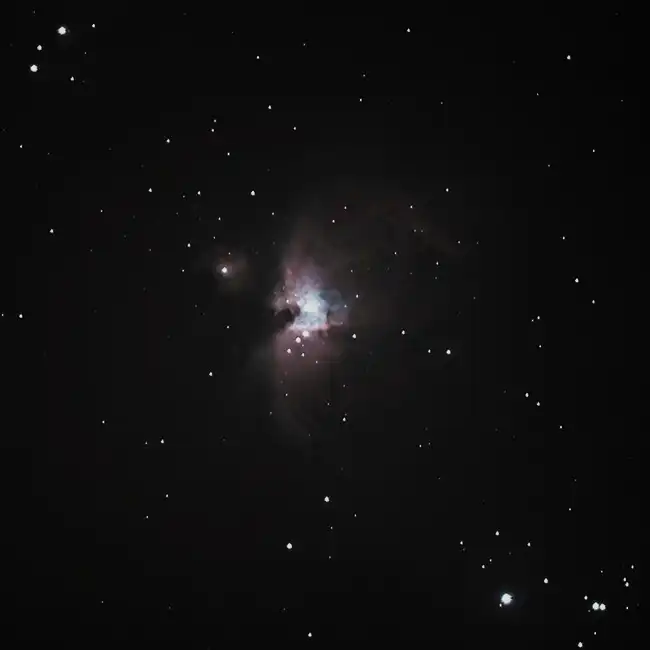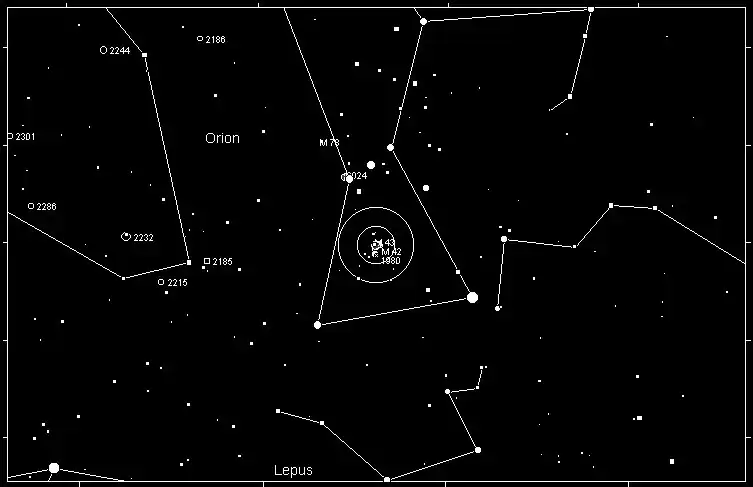Messier 42, also known as the Orion Nebula, is one of the most famous and visually stunning objects in the night sky. Located in the constellation Orion, it is a massive cloud of gas and dust where new stars are being born. The Orion Nebula is a favorite among amateur astronomers and a key subject of study for professional astronomers due to its proximity and the insight it provides into stellar formation.
Description
The Orion Nebula is a diffuse nebula situated about 1,344 light-years away from Earth. It spans about 24 light-years in diameter and is one of the brightest nebulae visible to the naked eye. The nebula is primarily composed of hydrogen gas, which glows brightly when ionized by the intense ultraviolet light emitted by the young, hot stars forming within it. These stars are grouped in a region known as the Trapezium, a tight cluster of four massive stars that illuminate the nebula.
Magnitude
Messier 42 has an apparent magnitude of 4.0, making it easily visible even from suburban areas with the naked eye, especially under dark skies. With binoculars or a small telescope, the nebula’s intricate details and the Trapezium stars become visible, revealing the nebula's complex structure.

Seasonal Visibility
The Orion Nebula is best observed during the winter months in the Northern Hemisphere. It is prominent in the sky from November through February, with its peak visibility in December and January. During these months, Orion dominates the southern sky, and the nebula is visible for most of the night.
Constellation
Messier 42 is located in the constellation Orion, one of the most recognizable constellations in the sky. Orion, the Hunter, is characterized by its three bright stars in a row, forming Orion's Belt. The nebula itself is found just below the belt, forming part of Orion's Sword.
Finding Messier 42
Locating Messier 42 is relatively easy, even for novice astronomers. First, identify Orion's Belt, which consists of the stars Alnitak, Alnilam, and Mintaka. From there, look southward (downward) to find a line of stars that form Orion's Sword. The nebula is located in the middle of this line and appears as a fuzzy patch of light to the naked eye or through binoculars.
When viewed through a telescope, even a small one, Messier 42 reveals its true beauty. The nebula’s bright core, surrounding gas clouds, and the Trapezium stars are the primary features. Higher magnifications will bring out more detail, including the dark lanes of dust that thread through the glowing gas.

History
The Orion Nebula has been known since ancient times, but it wasn’t recognized as a nebula until the invention of the telescope. The earliest known sketch of the nebula was made by the French astronomer Nicolas-Claude Fabri de Peiresc in 1610. In 1618, another early observation was made by Swiss astronomer Johann Baptist Cysat.
However, it was Charles Messier who cataloged it as M42 in 1769 while searching for comets. Messier's catalog, which was designed to help comet hunters avoid mistaking these deep-sky objects for comets, brought attention to the nebula. Later, in the 19th century, astronomer William Herschel and his son John studied the Orion Nebula extensively, revealing much of the structure we know today.
The nebula has since become a key object of study for modern astronomy, providing insights into the processes of star formation, the behavior of interstellar gas, and the dynamics of young stellar clusters. The Hubble Space Telescope has captured some of the most detailed images of Messier 42, uncovering new stars and protoplanetary disks, offering a glimpse into the early stages of solar system formation.
Conclusion
Messier 42, the Orion Nebula, is not just a beautiful object in the night sky; it is a window into the processes that shape the universe. Its visibility to the naked eye and its stunning appearance through telescopes make it a must-see for any stargazer, especially during the winter months. Whether you are an amateur astronomer or a seasoned professional, the Orion Nebula offers a captivating view and a reminder of the dynamic and ever-changing cosmos.
